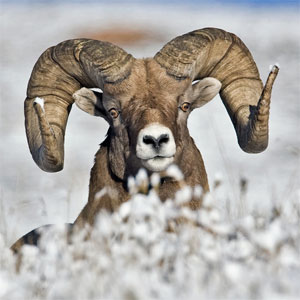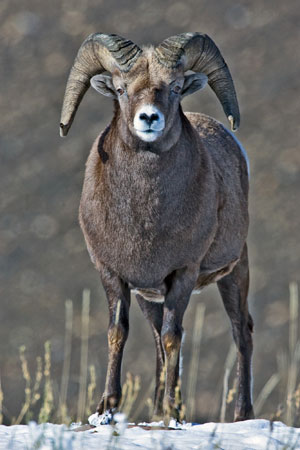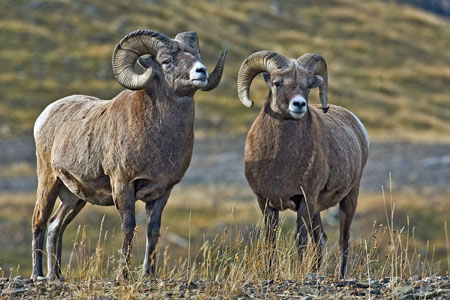
Home | About Us | Projects | Maps

Home | About Us | Projects | Maps
|
Bighorn Sheep (Ovis canadensis) 
Description: Bighorn Sheep are large mammals that are relatives of goats. They have short brown fur, a white muzzle and rump patch. They have split hooves which aid in balance and rough hoof bottoms for natural grip. Their sure footing help them move easily around rugged mountain terrain. The male Bighorn sheep is called a ram and can be recognized by his massive brown horns. The horns curl back over the ears, down, and up past the cheeks. By the time a ram reaches 7 or 8 years of age, he can have a set of horns with a full curl. 
Ewes, the females, are smaller than the rams and have shorter, smaller horns that never exceed half a curl.
Weight: avg. 90 kg or 198 lbs. Length with tail: 150 to 180 cm (59 to 71 in)
Range / Habitat: Bighorn sheep are found in central and eastern Washington. They are distributed spottily in discrete populations such as at Hall Mountain in the Selkirks; the Blue Mountains near Joseph Creek and the Wenaha-Tucannon Wilderness. Click the range map to learn more about the distribution of Bighorn Sheep in California. 
Diet: Bighorn Sheep are herbivores. They primarily graze on grasses, sedges and forbs. Bighorns have a complex 9-stage digestive process that allows them to maximize removal of nutrients from food of marginal quality. Behavior: Bighorn sheep are gregarious animals, forming herds of over 100 individuals. Small groups of 8-10 are more common. Mature males usually live apart from females and young during most of the year in bachelor herds. Males do not defend territories but rather engage in battles over mating access to a female. Bighorn sheep are well known for the head-to-head combat between males. Horn size is a symbol of rank in the herd. The mass of the horns is used to a male's best advantage as he smashes into an opponent at speeds of 20 miles per hour. Fortunately, Bighorn sheep have double-layered skulls reinforced with struts of bone for protection. Battles with a rival can last a full day. Bighorn have excellent eyesight, which helps them in jumping and gaining narrow mountain footholds. Reproduction: In the spring, lambs are born up on high, secluded ledges protected from predators such as coyotes, wolves, and cougars. They lambs are vulnerable to the golden eagles which target lambs. Mothers nurse the young for four to six months.
Did you know?

Bighorn Sheep More information: Ovis canadensis Information - Animal Diversity Web More photos: Bighorn sheep Photos Video: Watch Bighorn go head-to-head in this video |
Animal silhouettes available to purchase »
Photos: Natures Pics